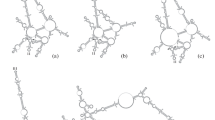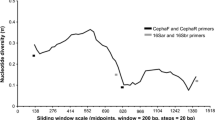Abstract
Seven species of Cylicocyclus Ihle, 1922 (Nematoda: Strongylidae) were collected from donkeys from Henan Province, China. Five samples of each species were selected for sequencing. Sixteen different internal transcribed spacer (ITS) sequences representing the seven species of Cylicocyclus were obtained. Sequence differences in the first internal transcribed spacer (ITS-1) among species was lower than that of the second internal transcribed spacer (ITS-2). Phylogenetic analyses were conducted using the combined ITS-1 and ITS-2 data sets from the present study and using reference sequences from the GenBank database. The MP and ML trees were similar in topology. The phylogenetic trees were divided into two clades. Clade I included 8 species of Cylicocyclus; within this group, Cylicocyclus leptostomus (Kotlan, 1920) is nested between different samples of Cylicocyclus ashworthi (LeRoux, 1924), suggesting C. ashworthi may represent a species complex. Clade II included Cylicocyclus elongatus (Looss, 1900) and Cylicocyclus ultrajectinus (Ihle, 1920); however, these two species always clustered with the comparative species (Petrovinema poculatum (Looss, 1900) and Poteriostomum imparidentatum Quiel, 1919), suggesting that C. elongatus and C. ultrajectinus represent members of other genera.
Similar content being viewed by others
References
Anjos D.H.S., Rodrigues M.L. 2006. Diversity of the infra-communities of strongylid nematodes in the ventral colon of Equus caballus from Rio de Janeiro state, Brazil. Veterinary Parasitology, 136, 251–257. DOI: 10.1016/j.vetpar.2005.05.070.
Bu Y.Z., Niu H.X., Gasser R.B., Beveridge I., Zhang L.P. 2009. Strongyloid nematodes in the caeca of donkeys in Henan Province, China. Acta Parasitologica, 54, 263–268. DOI: 10.2478/s11686-009-0037-z.
Bucknell D.G., Gasser R.B., Beveridge I. 1995. The prevalence and epidemiology of gastrointestinal parasites of horses in Victoria, Australia. International Journal for Parasitology, 25, 711–724. DOI: 10.1016/0020-7519(94)00214-9.
Chapman M.R., Kearney M.T., Klei T.R. 2003. Equine cyathostome population: accuracy of species composition estimations. Veterinary Parasitology, 116, 15–21. DOI: 10.1016/S0304-4017(03)00239-5.
Collobert-Laugier C., Hoste H., Sevin C., Dorchies P. 2002. Prevalence, abundance and site distribution of equine small strongyles in Normandy, France. Veterinary Parasitology, 110, 77–83. DOI: 10.1016/S0304-4017(02)00328-X.
Du C.X., Zhang L.P., Shi M.Q., Ming Z., Hu M., Gasser R.B. 2010. Elucidating the identity of Anisakis larvae from a broad range of marine fishes from the Yellow Sea, China, using a combined electrophoretic-sequencing approach. Electrophoresis, 31, 654–658. DOI: 10.1002/elps.200900531.
Gasser R.B., Hung G.C., Chilton N.B., Beveridge I. 2004. Advances in developing molecular-diagnostic tools for strongyloid nematodes of equids: fundamental and applied implications. Molecular and Cellular Probes, 18, 3–16. DOI: 10.1016/j.mcp.2003.10.001.
Gawor J.J. 1995. The prevalence and abundance of internal parasites in working horses autopsied in Poland. Veterinary Parasitology, 58, 99–108. DOI: 10.1016/0304-4017(94)00698-C.
Hartwich G. 1986. Zum Strongylus tetracanthus-Problem und zur Systematik der Cyathostominea (Nematoda: Strongyloidea). Mitteilungen aus dem Zoologischen Museum in Berlin, 62, 61–102.
Hung G.C., Gasser R.B., Beveridge I., Chilton N.B. 1999a. Species-specific amplification by PCR of ribosomal DNA from some equine strongyles. Parasitology, 119, 69–80.
Hung G.C., Chilton N.B., Beveridge I., Gasser R.B. 1999b. Secondary structure model for the ITS-2 precursor rRNA of strongyloid nematodes of equids: implications for phylogenetic inference. International Journal for Parasitology, 29, 1949–1964. DOI: 10.1016/S0020-7519(99)00155-1.
Hung G.C., Chilton N.B., Beveridge I., Gasser R.B. 1999c. Molecular evidence for cryptic species within Cylicostephanus minutus (Nematoda: Strongylidae). International Journal for Parasitology, 29, 285–291. DOI: 10.1016/S0020-7519(98)00203-3.
Hung G.C., Chilton N.B., Beveridge I., Gasser R.B. 2000. A molecular systematic framework for equine strongyles based on ribosomal DNA sequence data. International Journal for Parasitology, 30, 95–103. DOI: 10.1016/S0020-7519(99)00166-6.
Hung G.C., Chilton N.B., Beveridge I., McDonnell A., Lichtenfels J.R., Gasser R.B. 1997. Molecular delineation of Cylicocyclus nassatus and C. ashworthi (Nematoda: Strongylidae). International Journal for Parasitology, 27, 601–605. DOI: 10.1016/S0020-7519(96)00192-0.
Ihle J.E.W. 1925. Verzeichnis der Cylicostomum-Arten der Equiden mit Bemerkungen über einzelne Species. Zentralblatt für Bakteriologie, Abt. 1(95), 227–236.
Krecek R.C., Guthrie A.J. 1999. Alternative approaches to control of cyathostomes: an African perspective. Veterinary Parasitology, 85, 151–162. DOI: 10.1016/S0304-4017(99)00095-3.
Le Roux P.L. 1924. Helminths collected from equines in Edinburgh and in London. Journal of Helminthology, 2, 111–134.
Li M.W., Zhu X.Q., Gasser R.B., Lin R.Q., Sani R.A., Lun Z.R., Jacobs D.E. 2006. The occurrence of Toxocara malaysiensis in cats in China, confirmed by sequence-based analyses of ribosomal DNA. Parasitology Research, 99, 554–557. DOI: 10.1007/s00436-006-0194-z.
Lichtenfels J.R. 1975. Helminths of domestic equids. Illustrated keys to genera and species with emphasis on North American forms. Proceedings of the Helminthological Society of Washington (special issue), 42, 1–92.
Lichtenfels J.R., Kharchenko V.A., Dvojnos G.M. 2008. Illustrated identification keys to strongylid parasites (Strongylidae: Nematoda) of horses, zebras and asses (Equidae). Veterinary Parasitology, 156, 4–161. DOI: 10.1016/j.vetpar.2008.04.026.
Lichtenfels J.R., Kharchenko V.A., Kuzmina T.A., Krecek R.C. 2005. Differentiation of Cylicocyclus gyalocephaloides of Equus burchelli from Cylicocyclus insigne of Equus caballus (Strongyloidea: Nematoda). Comparative Parasitology, 72, 108–115. DOI: 10.1654/4148.
Lichtenfels J.R., Kharchenko V.A., Sommer C., Ito M. 1997. Key characters for the microscopical identification of Cylicocyclus nassatus and Cylicocyclus ashworthi (Nematoda, Cyathostominae) of the horse, Equus caballus. Journal of Helminthological Society of Washington, 64, 120–127.
Silva A.V.M., Costa H.M.A., Santos H.A., Carvalho R.O. 1999. Cyathostominae (Nematoda) parasites of Equus caballus in some Brazilian states. Veterinary Parasitology, 86, 15–21. DOI: 10.1016/S0304-4017(99)00078-3.
Thompson J.D., Higgins D.G., Gibson T.J. 1994. CLUSTALW: improving the sensitivity of progressive multiple sequence alignment through sequence weighting, positions-specific gap penalties and weight matrix choice. Nucleic Acids Research, 22, 4673–4680.
Wu X.Y., Chilton N.B., Zhu X.Q., Xie M.Q., Li A.X. 2005. Molecular and morphological evidence indicates that Pseudorhabdosynochus lantauensis (Monogenea: Diplectanidae) represents two species. Parasitology, 130, 669–677.
Zhang L.P., K’ung F.Y. 2002. Parasitc Nematodes from Equus spp. China Agriculture Press, Beijing, 175 pp. (in Chinese).
Zhu X.Q., D’Amelio S., Gasser R.B., Yang T.B., Paggi L., He F., Lin R.Q., Song H.Q., Lin A., Li A.X. 2007. Practical PCR tools for the delineation of Contracaecum rudolphii A and Contracaecum rudolphii B (Ascaridoidea: Anisakidae) using genetic markers in nuclear ribosomal DNA. Molecular and Cellular Probes, 21, 97–102. DOI: 10.1016/j.mcp.2006.08.004.
Author information
Authors and Affiliations
Corresponding author
Rights and permissions
About this article
Cite this article
Bu, Y., Niu, H. & Zhang, L. Phylogenetic analysis of the genus Cylicocyclus (Nematoda: Strongylidae) based on nuclear ribosomal sequence data. Acta Parasit. 58, 167–173 (2013). https://doi.org/10.2478/s11686-013-0124-z
Received:
Published:
Issue Date:
DOI: https://doi.org/10.2478/s11686-013-0124-z




